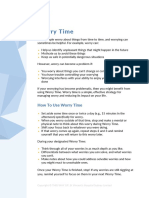100%(1)100% found this document useful (1 vote)
ABCD's of Anger
ABCD's of Anger
Uploaded by
Shannon KathleenThis document provides steps for dealing with anger using the ABCD method:
1) Acknowledge and admit your anger at what caused it
2) Backtrack to identify the primary emotion behind the anger
3) Consider the cause of that primary emotion
4) Determine how to positively deal with and address the issue that made you angry
Copyright:
© All Rights Reserved
Available Formats
Download as PDF, TXT or read online from Scribd
Download as pdf or txt
ABCD's of Anger
ABCD's of Anger
Uploaded by
Shannon Kathleen100%(1)100% found this document useful (1 vote)
This document provides steps for dealing with anger using the ABCD method:
1) Acknowledge and admit your anger at what caused it
2) Backtrack to identify the primary emotion behind the anger
3) Consider the cause of that primary emotion
4) Determine how to positively deal with and address the issue that made you angry
Original Description:
Part of: Anger Management Therapy Curriculum
Original Title
ABCD's of anger
Copyright
© © All Rights Reserved
Available Formats
PDF, TXT or read online from Scribd
Share this document
Did you find this document useful?
Is this content inappropriate?
This document provides steps for dealing with anger using the ABCD method:
1) Acknowledge and admit your anger at what caused it
2) Backtrack to identify the primary emotion behind the anger
3) Consider the cause of that primary emotion
4) Determine how to positively deal with and address the issue that made you angry
Copyright:
© All Rights Reserved
Available Formats
Download as PDF, TXT or read online from Scribd
Download as pdf or txt
100%(1)100% found this document useful (1 vote)
ABCD's of Anger
ABCD's of Anger
Uploaded by
Shannon KathleenThis document provides steps for dealing with anger using the ABCD method:
1) Acknowledge and admit your anger at what caused it
2) Backtrack to identify the primary emotion behind the anger
3) Consider the cause of that primary emotion
4) Determine how to positively deal with and address the issue that made you angry
Copyright:
© All Rights Reserved
Available Formats
Download as PDF, TXT or read online from Scribd
Download as pdf or txt
You are on page 1/ 2
How’s that working for you?
ABCD’s Of Anger
Acknowledge you are/were angry.
Admit and accept your anger.
“I was angry at _____ when he/she _____.”
Backtrack and identify the primary emotion(s).
Ask yourself what you were really feeling.
“What I really felt was ______ (i.e. hurt, frustration, etc.)
Consider the cause. (What contributed to the feelings?)
Ask yourself what happened and why you felt that way.
“I felt this way because _______.
Determine how to deal with it.
How did you respond to this situation?
What would it look like to address this anger issue in a positive
way?
Evaluate your response, what are your options?
Recognize that you may need to apologize or maybe you were
rightfully angry but remember, anger should lead you to a positive
outcome/response.
Making our needs known requires two things:
• We need to be able to identify what they are.
• We need to be able to communicate them effectively.
“I feel ________ (primary emotion) when ________ (what
happened.”
This presents two pieces of information about you to the other
person.
1) Tell the other person your interpretation of his or her
behavior.
2) It provides the opportunity for the other person to let you
know whether your interpretation is accurate.
Take responsibility for your feelings versus throwing out
accusations and initiating a defensive response from the other
person.
You might also like
- Ideas For Teaching Children About EmotionsNo ratings yetIdeas For Teaching Children About Emotions11 pages
- Anxiety and Panic Attacks 2021 PDF Version100% (1)Anxiety and Panic Attacks 2021 PDF Version23 pages
- Anxiety Management Understanding How to Overcome Worry Fear, Depression, & Panic AttacksFrom EverandAnxiety Management Understanding How to Overcome Worry Fear, Depression, & Panic AttacksNo ratings yet
- Adolescents Choosing Self-Harm As An Emotion RegulationNo ratings yetAdolescents Choosing Self-Harm As An Emotion Regulation14 pages
- 30 Activities To Work On Emotions With ChildrenNo ratings yet30 Activities To Work On Emotions With Children17 pages
- Emotional Self-Awareness: Dealing With: EmotionsNo ratings yetEmotional Self-Awareness: Dealing With: Emotions12 pages
- Schizophrenia: Symptoms of Schizophrenia (ICD-10)No ratings yetSchizophrenia: Symptoms of Schizophrenia (ICD-10)11 pages
- What Is Clinical Assessment and Clinical Diagnosis?No ratings yetWhat Is Clinical Assessment and Clinical Diagnosis?9 pages
- How To Heal From Self-Harming Behaviours?No ratings yetHow To Heal From Self-Harming Behaviours?4 pages
- Depression Types, Causes, Symptoms, Risk Factor, and TreatmentNo ratings yetDepression Types, Causes, Symptoms, Risk Factor, and Treatment7 pages
- 4 Foundations To Help Trauma-Impacted Youth100% (1)4 Foundations To Help Trauma-Impacted Youth4 pages
- When Im Feeling Jealous (Trace Moroney)No ratings yetWhen Im Feeling Jealous (Trace Moroney)6 pages
- Complete Download Trauma Informed Social Emotional Toolbox for Children and Adolescents 116 Worksheets and Skill Building Exercises to Support Safety Connection and Empowerment 1st Edition Lisa Weed Phifer PDF All Chapters80% (5)Complete Download Trauma Informed Social Emotional Toolbox for Children and Adolescents 116 Worksheets and Skill Building Exercises to Support Safety Connection and Empowerment 1st Edition Lisa Weed Phifer PDF All Chapters37 pages
- Logbook For Schema Triggering and Mode 1222 Analysis PDF100% (1)Logbook For Schema Triggering and Mode 1222 Analysis PDF1 page
- Sleep Inventory: Place Your Cursor in The Boxes To Fill Out Worksheet. Remember To Save Your AnswersNo ratings yetSleep Inventory: Place Your Cursor in The Boxes To Fill Out Worksheet. Remember To Save Your Answers3 pages
- Anger Management: A Step By Step Instruction Handbook on How To Control and Manipulate Excessive Anger In A Healthy and Safe WayFrom EverandAnger Management: A Step By Step Instruction Handbook on How To Control and Manipulate Excessive Anger In A Healthy and Safe WayNo ratings yet



























































